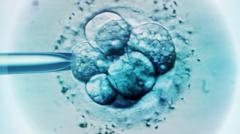A remarkable event has occurred in Ohio as a couple, Lindsey and Tim Pierce, welcomed their son, Thaddeus Daniel, born from an embryo that was frozen for more than 30 years. This birth has reportedly set a new world record, as it is the longest duration an embryo has been frozen before resulting in a successful live birth. Previously, the record was held by twins born in 2022 from embryos that had been frozen since 1992.
The Pierces endeavored to have a child for seven years before they explored the option of adopting an embryo. The embryo they used was created by Linda Archerd, who was undergoing IVF with her then-husband in 1994, and although four embryos were produced, only one developed into Ms. Archerd's now-30-year-old daughter. The remaining three embryos were preserved in storage, and despite divorcing, she opted to hold onto them rather than destroy or anonymously donate them.
For Ms. Archerd, it was crucial to stay connected to the child conceived from her embryo, as the baby would share familial ties with her daughter. She invested considerable resources in storage fees until she found Nightlight Christian Adoptions, a Christian embryo adoption agency, which operates a program named Snowflakes. These agencies regard their work as life-saving for the embryos.
Ms. Archerd expressed specific preferences for a couple who would adopt her embryos, favoring a married Caucasian Christian couple residing in the U.S. After matching with the Pierces, the adoption proceeded through the Rejoice Fertility clinic in Tennessee, which committed to transferring every embryo regardless of age.
The Pierces reported they did not set out to set records; they simply wished to start a family. Meanwhile, Ms. Archerd, who has yet to meet her new grandson in person, noted that she could already discern a resemblance between him and her daughter. This birth not only highlights a significant milestone in reproductive technology but also illustrates the emotional and ethical dimensions of embryo adoption.




















